There is only one, undisputed, king when it comes to Kaiju movies. No, it’s not freaking King Kong you damn Americans. That title belongs to Godzilla. Godzilla, or Gojira, is a legendary Kaiju created by Toho Studios way back in 1954. There are thirty-six movies currently with the Big G starring in them and, like all series, there have been some good and some bad films. As the first in my series of Worst to Best, I chose Godzilla because of two reasons. One is the longevity of the series. The Godzilla series has spanned 67 years to date. There really aren’t many film series’ with that kind of longevity or number of films to their name. The other reason is that I’ve been a huge Godzilla fan since I was five years old. I remember staying up for days watching the old Godzilla marathons on TNT back in the day! Here we go…

36. Godzilla (1998)
We’re scraping the bottom of the barrel with this abomination of a film. The much-maligned, universally hated, absolutely horrendous piece of shit that Tristar decided to regurgitate on us from 1998. This ‘Godzilla’ film should never have been made. Not only does the creature look like a mutated Iguana, but it also lacks everything that made Godzilla special. Guess what folks? It’s been twenty-plus years and this movie is still the biggest piece of shit that I have ever had the misfortune of viewing. A lot of people love the cartoon that came from this movie, and that’s totally your call there, but after watching this abortion one time I had absolutely no desire to watch it, or any potential sequels, ever again. I cannot even call this a film. Films are enjoyable. This is a movie and it is just awful. Honest to god though, if this movie had been called anything other than Godzilla then it could have been passable.
When you tie a movie to a legendary figurehead, you have to live up to that name otherwise it’s just a disappointment. Tristar failed miserably here, rushing production and not giving the movie any real test screenings before a memorial day release. I could go on and on and on but I’m not going to subject you to the vitriol that this movie makes me spew any longer. If you really want to watch it, be my guest, but don’t say that I didn’t warn you.

35. All Monsters Attack (Godzilla’s Revenge) – 1969
Okay so, All Monsters Attack was Toho trying to market Godzilla more to kids much like Gamera had done previously. A lot of people think that, because of this, the film should not be judged by the same merits that the others are. I can kind of see where they are coming from but at the same time, the film is just awful. It focuses on a young, bullied boy who escapes to Monster Island, in his imagination and befriends Godzilla’s son Minilla. The monster even talks to the boy. How much more directed to kids can you get here? The film has a positive message to it and addresses bullying in a unique way, but there isn’t much else redeeming about it. You’ve got a tiny Godzilla that can’t breathe fire unless his tail is stomped on, a giant cat-like bully monster and a weird as hell story.
The film doesn’t make a lot of sense to me, but at least I will watch this film as opposed to our previous entry. This may be regarded as one of the worst films in the Toho Godzilla franchise, but at least it’s not the train wreck that preceded it on this list. If you’ve got young kids and you want to introduce them to Godzilla, consider this film. Otherwise, it’s best left viewed in small doses.
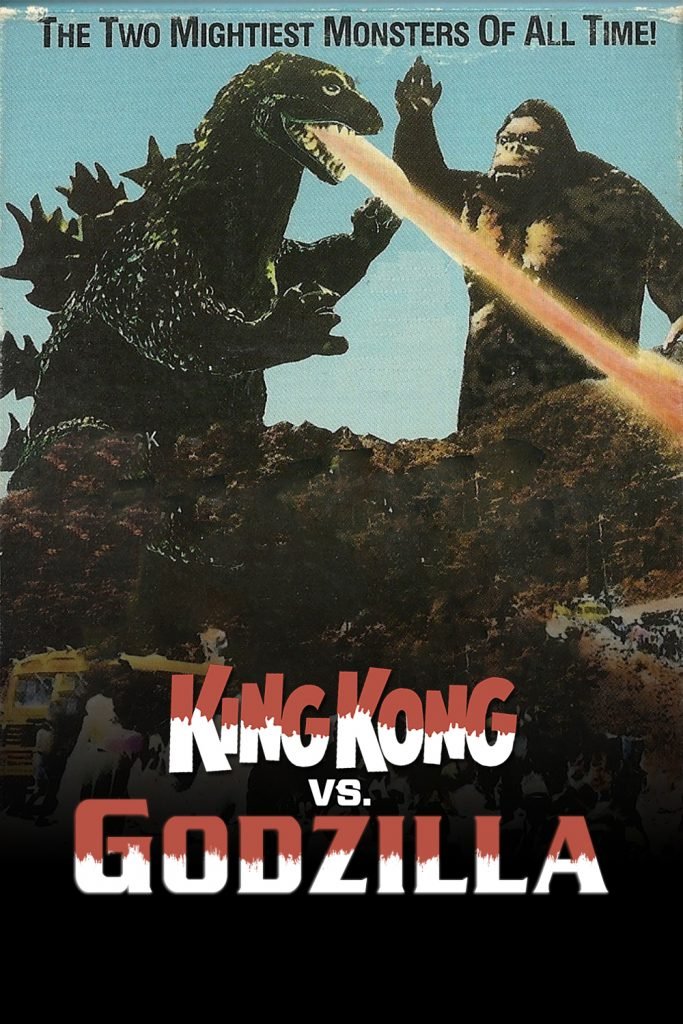
34. King Kong vs Godzilla – 1962
Believe it or not, 2021’s Godzilla vs Kong is not the first time these two Titans have faced off. Way back in Godzilla’s third outing, all the way back in 1962, we say the two kings face off for the first time. For the time, I’m sure the film was very well made. But watching this film after sixty years is honestly really hard to do. For one, there are scenes where it’s clearly hand puppets fighting each other, filmed at a great distance. Kong looks absolutely horrible in this film too. Let’s not forget that he gets struck by lightning during his fight with Godzilla and then develops lightning fingers. Lightning freaking fingers. If that’s not enough of a statement to make you roll your eyes then I don’t know what will. That said, this film is the most successful movie in the franchise, grossing Toho 352 million yen that year. The original Japanese version of King Kong vs. Godzilla is infamous for being one of the most poorly-preserved tokusatsu films.
In 1970, director Ishiro Honda prepared an edited version of the film for the Toho Champion Festival, a children’s matinee program that showcased edited re-releases of older kaiju films along with cartoons and then-new kaiju films. Honda cut 24 minutes from the film’s original negative and, as a result, the highest quality source for the cut footage was lost. For years, all that was thought to remain of the uncut 1962 version was a faded, heavily damaged 16mm element from which rental prints had been made. 1980s restorations for home video integrated the 16mm deleted scenes into the 35mm Champion cut, resulting in wildly inconsistent picture quality. The ending is also the source of a lot of controversy, as the film ends with Kong swimming away. The controversy comes from who fans think won the battle. Americans think Kong was the victor while the Japanese are adamant that Godzilla won. It’s up for debate some 60 years later.

33. Godzilla Raids Again – 1955
Okay, so we’re going back to 1955 for our next entry, the second film in the series. Critics loved this film and actually rated it better than the original film. However, I cannot agree with them. While the film introduces my favourite side-kick and second favourite Kaiju in Anguirus, the film just feels like a jumbled mess of a story for me. That said, it’s not a movie that is unenjoyable. It actually can be a pretty good watch if you’re in the mood for it. There are just moments and elements in the film that make me scratch my head. Ishirō Honda (director of Godzilla) noted that reviews for Godzilla Raids Again were more positive compared to the previous film, stating that it was considered “stupid” by the media for a director to add “ideas or themes” into a science fiction film, he commented, “That’s why I think that the first Godzilla was only considered a ‘weird’ movie.
That’s probably why they liked the second movie much better.” Godzilla Raids Again was distributed theatrically in Japan by Toho on April 24, 1955. The film generated 8.3 million tickets, less than what the first Godzilla film drew but still considered moderate business. The film drew little enthusiasm from audiences, the press, and Toho staff. Years later, Tanaka admitted that the crew had little time to prepare and hardly considers the film a success.

32. Son of Godzilla – 1967
In a contemporary review, the Monthly Film Bulletin declared the film to be “out of the top drawer of the Toho Company’s monster file, with the special effects department achieving their best results in monster locomotion” and that the film “has the advantage of a more soundly constructed story than most of its predecessors and a delightful vein of humor that allows for a gentle parody of the genre.” Like All Monsters Attack, I feel that this film is geared more towards children even though technically it isn’t. Toho wanted to create a baby Godzilla to appeal to the “date crowd” (a genre of films that were very popular among young couples during this time period), with the idea that girls would like a “cute” baby monster. For the idea behind Minilla, Fukuda stated, “We wanted to take a new approach, so we gave Godzilla a child. We thought it would be a little strange if we gave Godzilla a daughter, so instead we gave him a son”.
Fukuda also wanted to portray the monsters almost as people in regards to the father-son relationship between Godzilla and Minilla, as Fukuda stated “We focused on the relationship between Godzilla and his son throughout the course of Son of Godzilla.” The result is a monster that appeals more towards children than women. I’m sorry, but I just don’t care for this film all that much.

31. Godzilla: The Planet Eater – 2018
King Ghidorah is iconic in the Monsterverse. He’s arguably Godzilla’s greatest adversary and has been in more films than any other rival to the Big G. That said, the third anime feature that came to Netflix introduced us to a redesigned and re-imagined Ghidorah. I love the design of Godzilla in this series, but the design for Ghidorah is just awful. It looks nothing like the monster fans know and love. The story of the three-part series of movies is a bit convoluted and out there, but it could have been pretty epic. It had all the potential in the world to be innovative and be a phenomenal series of films. However, it falls short for me on every level. There are some good points in this movie, and the series wrapped up pretty well all things considered. But the getting there and the final adversary for Godzilla just didn’t live up to my expectations or hopes.

30. Godzilla: City on the Edge of Battle (2018)
So, this film could have been great, much like the previous entry. It had a good concept and then they absolutely blew it by making another one of Godzilla’s most memorable foes into a freaking city. It’s not a giant mechanized Godzilla, no, it’s been turned into a city. That’s right folks, they made MechaGodzilla into Mechagodzilla City. Naoya Fujita from IGN gave the film a 4.5 rating, indicating a “bad” rating, stating, “Godzilla: City on the Edge of Battle takes some promising ingredients, but cooks them into an unpalatable meal. We never really understand what the protagonists are fighting for, and there’s not even a satisfying scene of urban destruction (a Godzilla staple). It fails both emotionally and viscerally.”
James Grebey from Inverse called the film “bleakly pointless”, stating the film is “extremely self-serious, depressing and fairly light on fun” and called the film “the biggest bummer in Godzilla’s filmography.” James Perkins from HeyUGuys gave the film 3 stars out of 5, stating the film is “neither the best nor worst iteration of the Godzilla franchise but is most definitely made with the intention of trying something new but adding a heavy sci-fi and futuristic element to the famous monster.” I agree with the majority of critical statements, but I do love the animation of the films and that is really the only redeeming thing about it.

29. Godzilla: Planet of the Monsters (2017)
Brian Ashcraft of the Kotaku website felt that the characters “aren’t all that interesting” but did state that the “anime version of Godzilla is surprisingly effective and frightening” and that despite his complaints, the “overall experience was good” and “It’s not a perfect picture, but it was a powerful proof of concept: Godzilla works as an anime.” Matt Schley from The Japan Times praised the film’s CG animation, stating, “even sceptics will admit the 3-D version of the king of the monsters looks pretty darn cool” but felt the film wasn’t “nearly as thematically ambitious as its predecessor” and concluded by stating, “But still, with its impressive 3-D animation and action sequences, ‘Planet of the Monsters’ has the makings of something interesting.”
Callum May from Anime News Network gave the film an overall B+ rating, calling the film “not for the uninitiated”. May criticized the character of Haruo as being “grating”, as the film didn’t allow audiences to connect with other characters but praised the animation, call it Polygon’s “best-looking CG title yet” and concluded that the film “is a thrilling film that lives up to the reputation of the franchise and delivers on its science-fiction premise.”
I’m more in the camp with Ashcraft on this one. The CGI and Animations used for the trio of films were top notch and I love the attempt but for me, the films as a whole just fall flat on their faces. They’re far from being as bad as Godzilla 1998 but they’re still not great. That said, I’ll watch these three movies over G-98 any day of the week.

28. Ebirah, Horror of the Deep (1966)
A fun little tidbit about this film is that during its development, Ebirah, Horror of the Deep was intended to feature King Kong, but the character was replaced by Godzilla. This 1966 film is far from my favourite in the series, but it was the first film I actually saw of the Godzilla franchise. Therefore, despite its shortcomings, it holds a special place in my heart. Toho had decided to set the film on an island to cut back on special effects costs.
Sadamasa Arikawa has cited the film as a frustrating experience, stating, “There were major limitations on the budget from the studio. Toho couldn’t have made too many demands about the budget if Mr Tsuburaya had been in charge. The studio knew I was also doing TV work then, so they must have figured I could produce the movie cheaply.”
You can tell the movie was shot on the cheap and there really isn’t anything special about it. I bet this could have been a pretty decent Kong film, but we got Godzilla instead and it ranks where it does among them all.
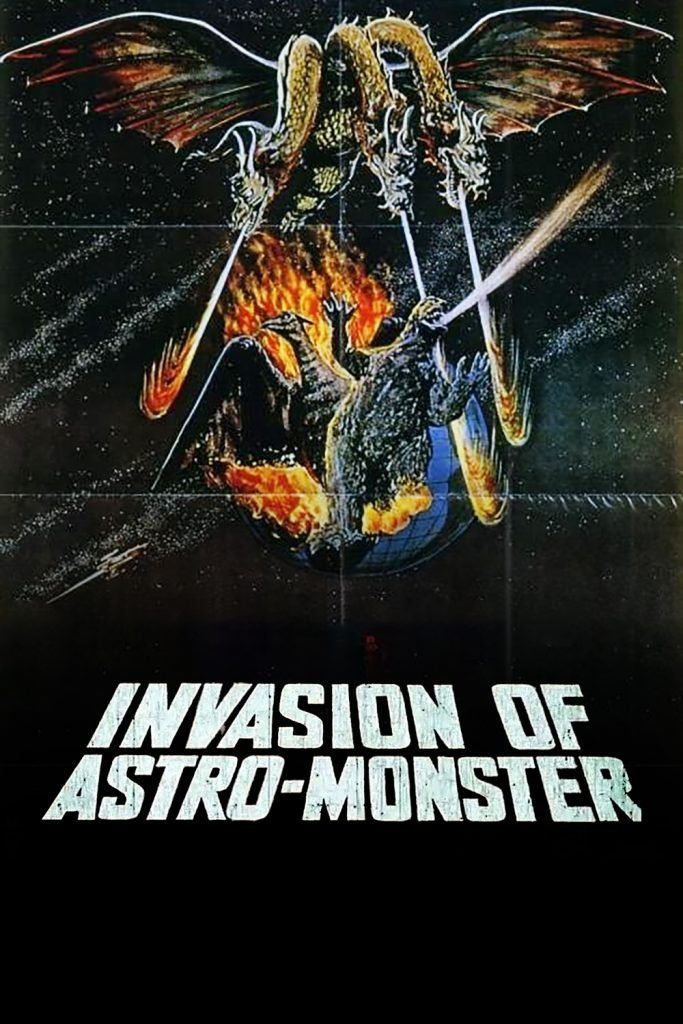
27. Invasion of the Astro-Monster (1965)
Godzilla on an alien planet, yay! All kidding aside, this is the second film featuring King Ghidorah and it is nowhere near as good as the first. It’s a pretty decent film, I’m not gonna lie, but it gets a bit… out there. Here’s a little snippet of the plot.. In the year 196X, two astronauts, Fuji and Glenn, are sent to investigate the surface of the mysterious “Planet X”. There they encounter advanced and seemingly benevolent human-like beings called the Xiliens and their leader the Controller.
The aliens usher the astronauts into their underground base, and moments later the surface is attacked by a creature that the Xiliens call “Monster Zero”, but which the astronauts recognize as King Ghidorah, a planet-destroying monster that had attacked Earth once before.
The monster eventually leaves, but the Controller states that King Ghidorah has been attacking repeatedly, forcing them to live underground in constant fear. He requests to borrow the Earth monsters Godzilla and Rodan to act as protectors to fight it once more (since 1964), in return for the cure for cancer (the English dub says that the formula can cure any disease). Pretty out there, right? There’s a whole twist and other stuff going on later in the film and it can be a bit hard to follow. Not a terrible film, but far from the best.
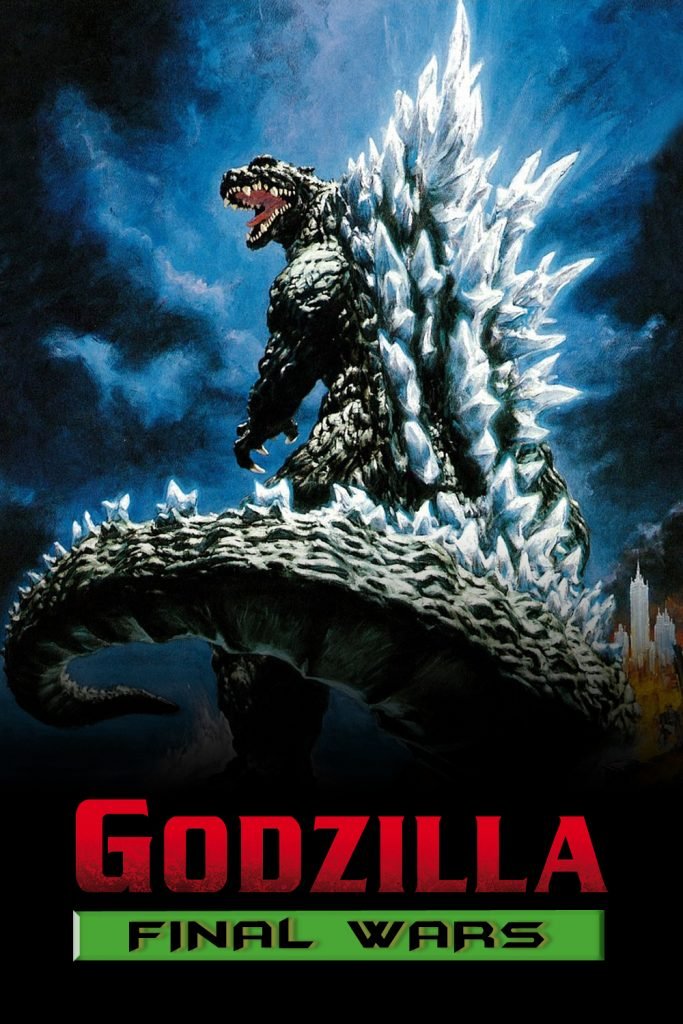
26. Godzilla: Final Wars (2004)
Final Wars coincided with the 50th anniversary of the franchise, and as such, the film features a variety of actors and kaiju from previous films. The monsters included were Godzilla, Mothra, Rodan, Gigan, Monster X/Keizer Ghidorah, Anguirus, Hedorah, Manda, Minilla, Kumonga, Kamacuras. Ebirah, King Caesar and Zilla (Godzilla design from 1998 film).
It is a fun film with lots of short monster fights and a killer soundtrack. This film has one of my favourite Godzilla moments in it too… It’s where Godzilla smashes Zilla into the Sydney Opera House and then destroys him with an atomic blast. Such a fitting end to such a deserving creature. That aside, the film was received well in Japan but not as well abroad.
Film review aggregator website Rotten Tomatoes gave the film a 55% rating, based on 12 reviews with a total score of 5.75/10. Steve Biodrowski of Cinefantastique called the film “utterly fantastic” and “a rush of explosive excitement.” Jim Agnew of Film Threat gave the film four and a half stars out of five, saying “the good news for kaiju fans is that Godzilla: Final Wars is a kick-ass giant monster flick.”
Drew McWeeny of Ain’t It Cool News remarked, “Godzilla: Final Wars earns a special place in my heart. It’s fun. Pure lunatic fun, every frame.” Sean Axmaker of Static Multimedia said, “Directed by a true fan of the old school, it’s lusciously, knowingly, lovingly cheesy.” It is super fun, I agree, but it is nowhere near the top of the list for Godzilla movies and that’s why it ranks at number 26.

25. Godzilla vs Megaguirus (2000)
So we’re starting the third list with Godzilla’s encounter with Megaguirus, a giant dragonfly-like creature with a big stinger on the tip of its tail. While I enjoy the hell out of this film, I have to admit that it has a lot of flaws and that’s why it ranks so low on the list. Let’s look at a bit of what has been said about this film. Ed Godziszewski of Monster Zero said, “While not the best example of filmmaking, Godzilla vs. Megaguirus nonetheless succeeds as an entertaining film.” Miles Imhoff of Toho Kingdom said, “Run-of-the-mill, mediocre, and sterile are the three words that best describe Godzilla vs. Megaguirus.
It is a movie that attempts to be creative and edgy, but somehow fails, leaving one wanting with futility to really try to enjoy the film.” Stomp Tokyo said “the music is pretty good” but “this movie isn’t a step forward in the ways that it really should be.”
Mike Bogue of American Kaiju said, “Though not the best of the post-Showa Godzilla movies, Godzilla vs. Megaguirus is one of the most entertaining.” Ian Jane of DVD Talk said, “While not the best entry in the Godzilla series, Godzilla vs. Megaguirus … is still a really solid entry with some great special effects and a very memorable monster mash finale.” So this one is your mileage may vary film and one that you should enjoy, but it is definitely not a film you want to use if introducing someone to Godzilla.
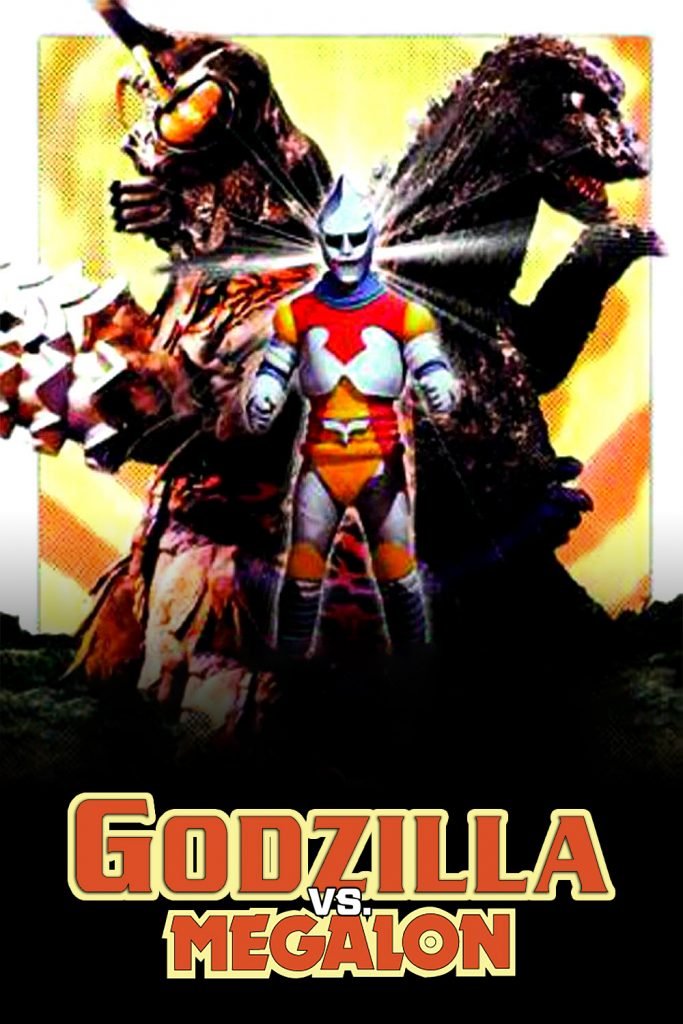
24. Godzilla vs Megalon (1973)
Godzilla’s encounter with Megalon introduced the world to the human-creation Jet Jaguar while also bringing back one of the more iconic villains in Gigan. Another of the films that I personally enjoy to a degree but this film has drawn the ire of Godzilla fans for decades. The film contributed to the reputation of Godzilla films in the United States as cheap children’s entertainment that should not be taken seriously. It has been described as “incredibly, undeniably, mind-numbingly bad” and one of the “poorer moments” in the history of kaiju films. In particular, the special effects of the film have been heavily criticized. One review described the Godzilla costume as appearing to be “crossed with Kermit the Frog” and another sneeringly compared it to Godzilla vs. Gigan, stating that it did “everything wrong that Gigan did, and then some.”
However, most of the criticism is of the lack of actual special effects work, as most of it consists of stock footage from previous films, including Godzilla vs. Gigan and Ghidorah, the Three-Headed Monster, but a few pieces of effects work have garnered praise, specifically a scene where Megalon breaks through a dam and the draining of the lake. The other aspects of the film have been similarly skewered. The acting is usually described as flat and generally poor, and as not improving, or sometimes, worsening, the already weak script. One part of the film, on the other hand, has garnered almost universal praise: Godzilla’s final attack on Megalon, a flying kick. It has been called the saving grace of the film and was made famous by the mock exclamations of shock and awe displayed on Godzilla vs. Megalon’s appearance on Mystery Science Theater 3000. From the end of season three to the middle of season five, that clip would be shown at the opening of each show. Despite all this, the film is also one of the most widely seen Godzilla films in the United States — it was popular in its initial theatrical release, largely due to aggressive marketing campaigns. Yet another YMMV film in the series.

23. Godzilla 2000: Millenium (1999)
The first Godzilla film that I had the privilege to see in theatres, Godzilla 2000 will always hold a special place in my heart. Not to mention it has one of the coolest (in my opinion) enemy Kaiju that Godzilla has ever faced off against. The North American release of Godzilla 2000 was met with mixed critical responses. Bruce Westbrook of the Houston Chronicle said the film “taps into a now-rare and innocent sense of wonder,” and that “its action scenes are well-conceived,” summarizing it as “a lovably amusing foray into vapid plotting, bad dubbing and men in rubber suits trashing miniature sets.” Owen Gleiberman of Entertainment Weekly gave the film a “B” grade, saying that Godzilla 2000 “lands on an imaginative fault line somewhere between tackiness and awe.”
Jay Carr of The Boston Globe called Godzilla 2000 “a ton of fun, and then some.” Lou Lumenick of the New York Post said “it’s great to have the big guy back.”
James Berardinelli of ReelViews said the film “uses the Godzilla formula effectively” and “represents solid, campy, escapist entertainment.” Maitland McDonagh of TV Guide praised the film, saying that “fans won’t want to miss this addition to the canon.” Susan Wloszczyna of USA Today said Godzilla 2000 “may be dull, but the familiarity of it all makes it feel ceremonial, a reassuring ritual.” David Edelstein of Slate said that he “periodically tranced out,” but added that “it’s fun to see” and “it still manages to dispel some of the lingering stinks of Roland Emmerich’s 1998 remake.” Stephen Holden of the New York Times wasn’t impressed, saying that “only a die-hard fan of the long-running Japanese Godzilla series could love Godzilla 2000.” Similarly, Stephen Hunter of the Washington Post remarked, “Godzilla, go home.” Among kaiju-related websites, Stomp Tokyo said “there are some pretty impressive special effects,” and concluded that “Godzilla 2000 delivers fairly well, if not spectacularly.” Toho Kingdom criticized the Japanese version, saying “it’s not hard to see why Godzilla 2000 was poorly received in Japan,” but added that “the US version … is infinitely better than its poorly paced Japanese counterpart. In all, the US version made numerous badly needed cuts from the film to tighten it up.”
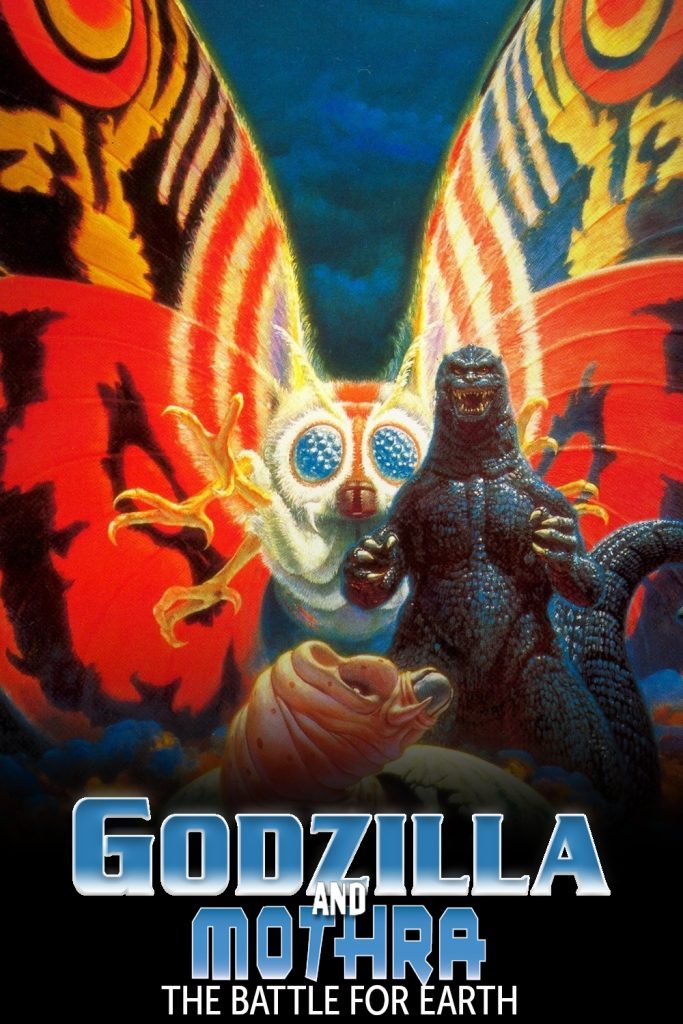
22. Godzilla vs Mothra (1992)
Godzilla’s second ‘titled’ battle against Mothra introduced us to the guardian’s counterpart Battra and I absolutely loved this film, but unfortunately, I didn’t love it enough for it to crack the top 20. Review aggregation website Rotten Tomatoes has a 75% approval rating from critics, based on 8 reviews with an average score of 6.3/10. Ed Godziszewski of Monster Zero said, “Rushed into production but a few months after Godzilla vs. King Ghidorah, this film is unable to hide its hurried nature [but] effects-wise, the film makes up for the story’s shortcomings and then some.”
Japan Hero said, “While this movie is not the best of the Heisei series, it is still a really interesting movie. The battles are cool, and Battra was an interesting idea. If you have never seen this movie, I highly recommend it.” Stomp Tokyo said the film is “one of the better Godzilla movies in that the scenes in which monsters do not appear actually make some sort of sense. And for once, they are acted with some gusto, so that we as viewers can actually come to like the characters on screen, or at least be entertained by them.” Mike Bogue of American Kaiju said the film “[does] not live up to its potential”, but added that “[its] colourful and elaborate spectacle eventually won [him] over” and “the main story thread dealing with the eventual reconciliation of the divorced couple adequately holds the human plot together.” So, personally, I could do without the majority of the human plots of Godzilla movies, and that is the very reason why this film ranks 22nd for me. It was just annoying to me. That said, this is one of the few lower ranked Godzilla films you can show to a newbie and it will be a good choice.

21. Terror of Mechagodzilla (1975)
The least-attended Godzilla film in Japan and also one of only two Godzilla films to sell less than 1 million tickets. I loved the concept for the secondary villain Titanosaurus, but it just wasn’t executed well enough nor was it a believable opponent for the big G. Much like Ebirah before it, Titanosaurus can use his fan to cause winds and that’s about it. Then there’s the iconic Mechanized Godzilla, dubbed Mechagodzilla, and this being its second outing at least it put up a bit of a better fight for most of the film. Toho titled its English version of the film Terror of Mechagodzilla and had it dubbed into English in Hong Kong. The film was given a North American theatrical release in March 1978 by independent distributor Bob Conn Enterprises under the title The Terror of Godzilla. Just as Cinema Shares had done with the previous three Godzilla movies, Bob Conn Enterprises chose to utilize the Toho-commissioned English dub instead of hiring a new crew to re-dub the film.
The Terror of Godzilla was heavily edited to obtain a “G” rating from the MPAA. Several scenes with violent content were entirely removed, disrupting the flow of the narrative.
Henry G. Saperstein, who sold the theatrical rights to Bob Conn Enterprises, also released the film to television in late 1978, this time under Toho’s international title, Terror of Mechagodzilla. Unlike The Terror of Godzilla, the television version remained mostly uncut, with only the shot of Katsura’s naked breasts excised. Saperstein’s editors also added a 10-minute prologue that served as a brief history of Godzilla, with footage from Saperstein’s English versions of Invasion of Astro-Monster and All Monsters Attack (the latter of which utilized stock footage from both Ebirah, Horror of the Deep and Son of Godzilla). In the mid-1980s, the U.S. television version, Terror of Mechagodzilla, was replaced by the theatrical edit, The Terror of Godzilla, on television and home video. For some reason, the title was also changed to Terror of Mechagodzilla…

20. Godzilla; King of the Monsters (2019)
Number 20 belongs to 2019’s King of the Monsters. Now, I personally loved this movie and I feel like they did a great job with each of the focal monsters and the battles between them, but I had an issue with how the human element was handled in the film. The whole human plot just seemed convoluted and unnecessary to me, especially when you’ve got the big 4 of Toho monsters on screen.
Come on guys, You could have easily focused 80% of the film on Godzilla, Mothra, Rodan and Ghidorah but instead, you gave us the ridiculous plot for the humans to fill in between monster sightings. I may be in the minority here, but I want Kaiju films to be 75-80% Monster action and 20-25% human focus. Most human subplots in the Godzilla movies are dull, with a few exceptions, and this one is why it ranks so low on the list.

19. Godzilla, Mothra and King Ghidorah: Giant Monsters All Out Attack (2001)
We’ve got a doozy of a plot for number 19’s Godzilla, Mothra and King Ghidorah: Giant Monsters All-Out Attack. It goes something like this… Strange incidents begin to occur when an American submarine has been destroyed by a mysterious force at sea off the shores of Guam. Only Admiral Tachibana was certain that behind the disaster was none other than the destructive King of the Monsters, Godzilla! 50 years after his attack on Tokyo in 1954, Godzilla has mysteriously returned to life to destroy Japan, and General Tachibana, whose parents died in the monster’s destructive wake, was prepared for his return to protect Japan from yet another tragic disaster but is dismissed by the overly confident Japanese government, who underestimate Godzilla’s power. But to further prove Tachibana’s claim, his daughter Yuri, who works for the TV news program “Digital Q,” investigates strange phenomena in three separate areas in Japan (two of which involve the deaths of immoral youths), and meets a mysterious old man named Isayama, who proclaims that aside from his infamous nuclear origins.
Godzilla is an accumulation of vengeful souls (of both Japanese and non-Japanese) abandoned to die in the Pacific War, and thus, mere weapons cannot kill him. While Tachibana has now been vindicated by the government, Isayama awakens the Three Sacred Guardian Beasts of Yamato, which protected Japan in its ancient past, and were then put into hibernation in the aforementioned three areas of Japan. The three monsters, King Ghidorah (sky), Mothra (water) and Baragon (earth), fight the rampaging Godzilla, while Tachibana also prepares to go into battle against his old radioactive nemesis. A lot to take in, isn’t it? It’s a good watch if a bit out there for the plot. Especially since Ghidorah is a protector of Earth in this film and not an enemy.

18. Godzilla vs Mechagodzilla 2 (1993)
We’ve got our 3rd Mechagodzilla appearance at #18. Godzilla vs Mechagodzilla 2 follows as a direct sequel to 1991’s Godzilla vs King Ghidorah where the United Nations establishes the United Nations Godzilla Countermeasures Center (UNGCC) to stop Godzilla. Their military branch, G-Force, salvages Mecha-King Ghidorah’s remains and use them to reverse engineer two anti-Godzilla machines: an aerial gunship called Garuda and a mecha modelled after Godzilla called Mechagodzilla. This film introduces the adorable Baby Godzilla as well as an improved version of Rodan entitled Fire Rodan. It’s not a sequel at all to any of the Mechagodzilla films that came before it and it marks the first time that Mecha-G fought for the humans and not trying to destroy them all. Monster Zero said that “some critical flaws exist” but felt overall that “of all the films of the [Heisei era], Godzilla vs MechaGodzilla II represents Toho’s most technically and artistically successful effort,”
Adding that “the action sequences in this film are impeccable… excitingly staged, logical, and quite dramatic.” American Kaiju said the film “stumbles in the areas of both story and special effects” but concluded it to be “a good, solid entry in the Godzilla series,” saying that “the battles between Godzilla and Mechagodzilla entertain” and “Akira Ifukube’s music score soars.” Japan Hero said “the story was interesting,” “the soundtrack is plain gorgeous,” and “the costume designs are just as great,” concluding: “While this is not my top favorite movie [of the Heisei series], it is definitely one of the best.”

17. Shin Godzilla (2016)
Shin Godzilla marks perhaps the most drastic change to Godzilla’s look over his tenure, and also is the first time he has ever had to go through metamorphosis phases. An unknown accident occurs in Tokyo Bay’s Aqua Line, which causes an emergency cabinet to assemble. All of the sudden, a giant creature immediately appears, destroying town after town with its landing reaching the capital. This mysterious giant monster is named “Godzilla”. His design is actually really creepy, but with this new design comes new powers. Like shooting lasers from his dorsal spines and a much more destructive breath attack. Something that was hinted at the end of the film, but has yet to be explored, is that it seems to reproduce asexually, as miniature Godzilla’s can be seen frozen in place on the tip of the creature’s tail. It is one of the strangest and darkest films in the series and I love it for that reason. Godzilla is such a destructive force and a despair-inducing presence.
I wish they had followed up with a sequel though… maybe someday. hin Godzilla received critical acclaim from Japanese critics, while Western critics gave it a more mixed response. The special effects and new depiction of Godzilla were praised but the film was criticized for its long scenes, confusing dialogue, over-crowded characters and subplots. On Rotten Tomatoes, the film has an approval rating of 86% based on 73 reviews, with an average rating of 6.70/10. The site’s consensus reads: “Godzilla: Resurgence offers a refreshingly low-fi – and altogether entertaining – return to the monster’s classic creature-feature roots.” On Metacritic, the film has a score of 67 out of 100 based on 14 critics, indicating “generally favorable reviews.” Japanese pop culture site RO65 called the film a “masterpiece of unprecedented filmmaking”, and felt that the film retains a “strong respect for the fundamental message within Godzilla”. Oricon Style praised directors Hideaki Anno and Shinji Higuchi for their realistic approach and the film’s reality vs. idealism themes, calling it a “world class” Godzilla film. Cinema Today called the film a “thrilling experience” and a “masterpiece”, feeling that the film was a return to form similar to 2004’s Dawn of the Dead. Kazuo Ozaki from Eiga.com praised the film as well, stating, “Hollywood, even with all its money, can’t approach this kind of perfection” while Koichi Irikura of Cinema Today called it a “birth of a masterpiece that boldly announces the revival of a Japanese Godzilla”.
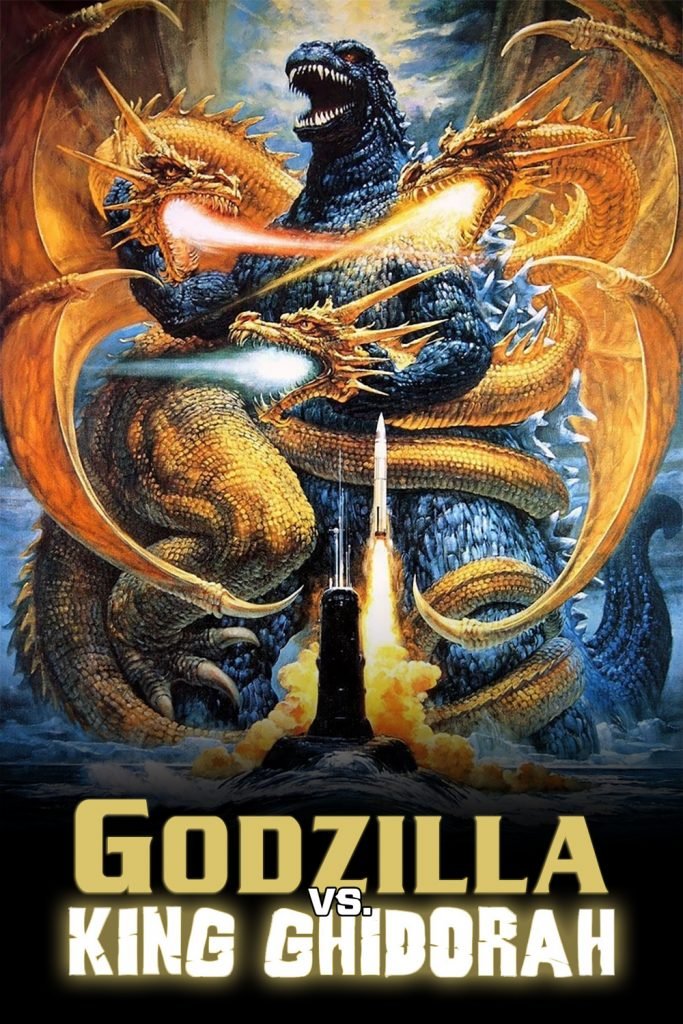
16. Godzilla vs King Ghidorah (1991)
One of the more controversial and less well critically received films graces us at #16. Critics wrote stuff like… Joseph Savitski of Beyond Hollywood said “This entry in the popular monster series is a disappointing and flawed effort unworthy of the “Godzilla” name.” Film historian and critic David Kalat wrote “Despite its shortcomings, illogic, and overpopulated cast, Godzilla vs. King Ghidorah is crammed full of ideas, richly visualized innovations, a genuine spirit of fun, and some of the most complex emotional manipulations ever to grace the series.” As for the controversy.. The film was considered controversial at the time of its release, being contemporary to a period of economic tension between America and Japan, but mainly due to its fictional World War II depictions…
Gerald Glaubitz of the Pearl Harbor Survivors Association appeared alongside director Kazuki Ōmori on Entertainment Tonight and condemned the film as being in “very poor taste” and detrimental to American-Japanese relations. Ishirō Honda also criticized Ōmori, stating that the scene in which Godzilla attacks and crushes American G.I.s went “too far”. Conversely, Godzilla historian Steve Ryfle said American media reports of supposed anti-Americanism “weren’t really thought-provoking or insightful.” Ōmori has denied all such allegations, stating that the American extras in the film had been “happy about being crushed and squished by Godzilla.” All that said, I love this film but it just barely misses the top 15. It introduced us to an awesome version of King Ghidorah, the monster fights were spectacular and the human plot wasn’t as terrible as most films are. It was actually a bit interesting. Give this one a watch, it’s definitely worth it.
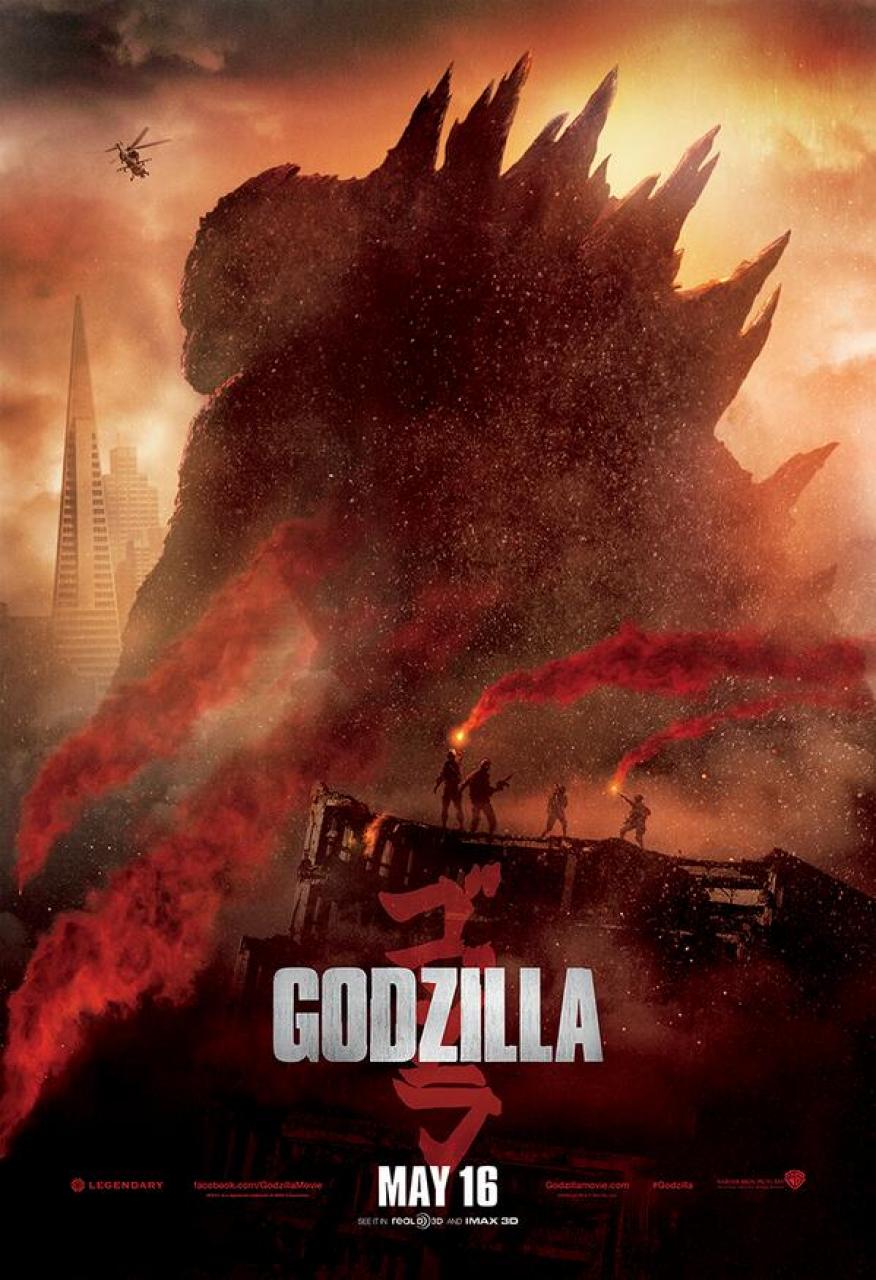
15. Godzilla (2014)
Where Tristar failed back in 1998 with their attempt at a Godzilla film, Legendary hit a home run with their first of three Godzilla movies. Sure, they had no rights to any of Toho’s legendary creations except Godzilla, but even with that restriction, it was a really good movie that I saw seven times in theatres. Godzilla received generally positive reviews from critics. On Rotten Tomatoes, the film has an approval rating of 76% based on 327 reviews, with an average rating of 6.70/10. The site’s critical consensus states, “With just enough human drama to anchor the sweeping spectacle of giant monsters smashing everything in sight, Gareth Edwards’ Godzilla satisfyingly restores the franchise’s fire-breathing glory.” On Metacritic, which assigns a weighted average based on selected reviews, the film has a score of 62 out of 100, based on 48 critics, indicating “generally favourable reviews”. CinemaScore reported that audiences gave the film an average grade of “B+” on an A+ to F scale.
Japanese critics and journalists have praised the film for putting “more of an effort to honour the spirit and visual style of the Japanese series” but criticized the film for “complicating the anti-war, anti-nuclear sensibility” and “lack of nerve on the part of the filmmakers to say anything substantial about nuclear weapons or nuclear energy”. However, Godzilla illustrator Yuji Kaida called the film “a real kaijū eiga (monster movie) that honoured the original in that Godzilla was presented as a force beyond human understanding that maintained the Earth’s natural balance”.

14. Godzilla vs Kong (2021)
The third of the Legendary Films Godzilla movies hit the list at number fourteen. Godzilla vs Kong is perhaps the studio’s best film to date. You have two absolutely legendary monsters in Godzilla and King Kong, you bring in one of Godzilla’s biggest adversaries in Mecha-Godzilla (which looked totally badass and was the closest any monster has come to killing Godzilla outside of Destroyah), and you limited the human element to a background plot which is where it belonged. Where Godzilla and King of the Monsters failed, GvK just took the best parts of both films and made it into a movie that blew the other two out of the water. Godzilla vs. Kong received generally positive reviews from critics. On Rotten Tomatoes, 76% of 373 critics have given the film a positive review, with an average rating of 6.4/10.
The website’s critics consensus reads, “Delivering squarely on its title, Godzilla vs. Kong swats away character development and human drama to deliver all the spectacle you’d expect from giant monsters slugging it out.” According to Metacritic, which assigned a weighted average score of 59 out of 100 based on 57 critics, the film received “mixed or average reviews.” Audiences polled by CinemaScore gave the film an average grade of “A” on an A+ to F scale (the highest of the MonsterVerse), while PostTrak reported 86% of audience members gave it a positive score, with 74% saying they would definitely recommend it. Richard Roeper of the Chicago Sun-Times gave the film 3 out of 4 stars, writing, “Godzilla vs. Kong is the kind of movie you can pretty much forget about almost instantly after you’ve seen it — but it’s also the kind of movie that makes you forget about everything else in your life while you’re watching it.” Jamie Graham of Total Film gave the film 3 out of 5 stars, writing, “Watching these famous monsters share the screen for the first time since 1963’s King Kong vs. Godzilla, in a series of expertly choreographed battles, packs a real wallop, even if you can’t help wishing that screen was 30ft high at your local cinema.

13. Godzilla: Tokyo S.O.S. (2003)
This is perhaps the first, and only, the true direct sequel of the Toho Godzilla films as it takes place immediately after Godzilla against Mechagodzilla. Honestly, this one was a bit hard for me to place originally, but after much deliberation, I settled on it being just shy of the top 10. It’s a really solid addition to the franchise and it’s one of the better films in the Millennium Era. Godzilla: Tokyo S.O.S. has received generally positive reviews from journalistic reviewers upon its release on DVD. John Sinnott of DVD Talk gave Tokyo S.O.S. four stars out of five, saying: “There are some problems with this movie, but when all is said and done, I really enjoyed it…While this movie seems to be aimed at a younger audience without a lot of plot or characterization, it was still a lot of fun. The fight scenes were exciting and though they took up most of the movie, they never dragged on or got boring.”
Giving the film a score of three out of five, Stomp Tokyo said “the plot is fairly simplistic and the character relationships are painted in broad strokes,” but added that the movie “[features] the best monster action Toho has produced.” Joseph Savitski of Beyond Hollywood criticized the film’s “uninspired script,” which he wrote had “ideas [that] are never fully developed,” but added that the film is “well-made” and “makes for an entertaining 91 minutes.” Mark Zimmer of Digitally Obsessed gave Tokyo S.O.S. a “B” score, calling it “a fun enough action film with enough explosions and destruction of Tokyo to satisfy die-hards and casual fans alike.”

12. Godzilla against Mechagodzilla (2002)
The best film of the Millennium Era of Toho films, Godzilla against Mechagodzilla takes the number twelve spot for me. As good as this film and its direct sequel are, it doesn’t quite put them in the top 10 of the all-time films. This has one of the better critical receptions of the later Toho films as well. One thing you have to remember about the millennium films is that they all ignore each other and every other Godzilla film saves for the original from 1954. The lone exception is this films sequel. Reviews of Godzilla Against Mechagodzilla have been positive. Mike Pinsky of DVD Talk gave the film three stars out of five, saying: “While I did have some minor complaints, [this is] a fine entry in the series.” Pinsky said “the plot is more interesting than most giant monster movies,” and “the battle scenes, which are the main reason anyone watches these films to begin with, were great.”
Giving the film a “B+” score, Mark Zimmer of Digitally Obsessed said that it’s “a good deal of fun and one of the better entries in the series.” Digital Monster Island gave the film a “B” score, calling it “a fun and exciting film that should please most kaiju fans.

11. Destroy All Monsters (1968)
Boasting a total monster count of 11, including Godzilla, Mothra, Rodan, King Ghidorah, Anguirus, and Minilla, Destroy All Monsters from 1968 finds itself just shy of the top 10. Critics may not have loved this movie, but I sure as hell did. It’s one of the more ambitious films from the Shōwa era and it’s definitely earned its status as a cult classic. From contemporary reviews, both Variety and Monthly Film Bulletin noted the film’s best scenes involved the monsters together while criticising the filmmaking. Variety reviewed the English-dubbed version of the film stating that it may appeal to “Sci-fi addicts and monster fans” while stating that the “plot is on comic strip level, special effects depend on obvious miniatures and acting (human) is from the school of Flash Gordon” and that the film’s strength relied on its “monster rally”. The Monthly Film Bulletin opined that “the model work is poor, and as usual the script is junior comic-strip”.
Both reviews mentioned the monsters’ final scene with Variety commenting that it was “clever” and the Monthly Film Bulletin stating that “apart from [the monsters] statutory devastation of world capitals. the monsters have disappointingly little to do until they get together in the last reel for a splendid battle” The Monthly Film Bulletin commented that the film was “almost worth sitting through the banalities for the final confrontation on Mount Fuji” noting the son of Godzilla “endearingly applauding from a safe distance” and “the victorious monsters performing a celebratory jig”. From retrospective reviews, Steve Biodrowski of Cinefantastique commented that the film “is too slim in its storyline, too thin in its characterizations, to be considered a truly great film. But for the ten-year-old living inside us all, it is entertainment of the most awesome sort.” Matt Paprocki of Blogcritics said the film is “far from perfect” and “can be downright boring at times” but felt that “the destruction scenes make up for everything else” and “the final battle is an epic that simply can’t be matched”. The film is considered a cult favourite among fans of the Godzilla franchise. In Steve Ryfle and Ed Godziszewski’s 2017 book covering Ishiro Honda’s filmography, they expressed that Destroy All Monsters is now seen as the “last truly spirited entry” in Toho’s initial series of kaiju films, due to “its audacious and simple story, a bounty of monsters and destruction, and a memorably booming soundtrack from Akira Ifukube”.

10. Godzilla Returns aka Godzilla 1985 (1984)
While I rank this one just making the Top 10, Godzilla Returns holds a special place in my heart. It was the very first Godzilla movie that I ever saw and I absolutely fell in love with the movies thanks to this film. I’m not saying the film doesn’t have its flaws, Godzilla responding to bird calls for example, but the series returned to its roots for the most part here and that’s why I love it. Despite its American re-edit receiving negative reviews, the original Japanese cut of the film has been much more well-received, with critics and fans praising the film’s score, practical effects, and its darker tone. In 1985, the film won the Japan Academy Award for Special Effects. The American re-edit, Godzilla 1985, was negatively received by critics.
Roger Ebert, who gave the film one star in the Chicago Sun-Times, argued that a film can only succeed as a “so bad it’s good” experience if the filmmakers have made a sincere effort to create a good film, and pointed out evidence that the makers of Godzilla 1985 were instead deliberately trying to create a “so bad it’s good” film, such as how the dialogue is consistently rather than occasionally awful, the conspicuous lack of synchronization in the lip-synching, and the inconsistency of Godzilla’s size. He also derided Raymond Burr’s scenes due to his character’s lack of dramatic involvement with the plot. Tom Long of the Santa Cruz Sentinel similarly derided the inconsequentiality of Burr’s role. While he considered the film more successful as a “so bad it’s good” experience than Ebert did, he felt the appeal got old after the first half hour: “After that you start thinking about all the other things you could be doing instead of watching the same joke repeat itself for another hour.” Take critics words with a grain of salt, I say. I love this film as I said above, and I feel more would if they watched the original version out of Japan.
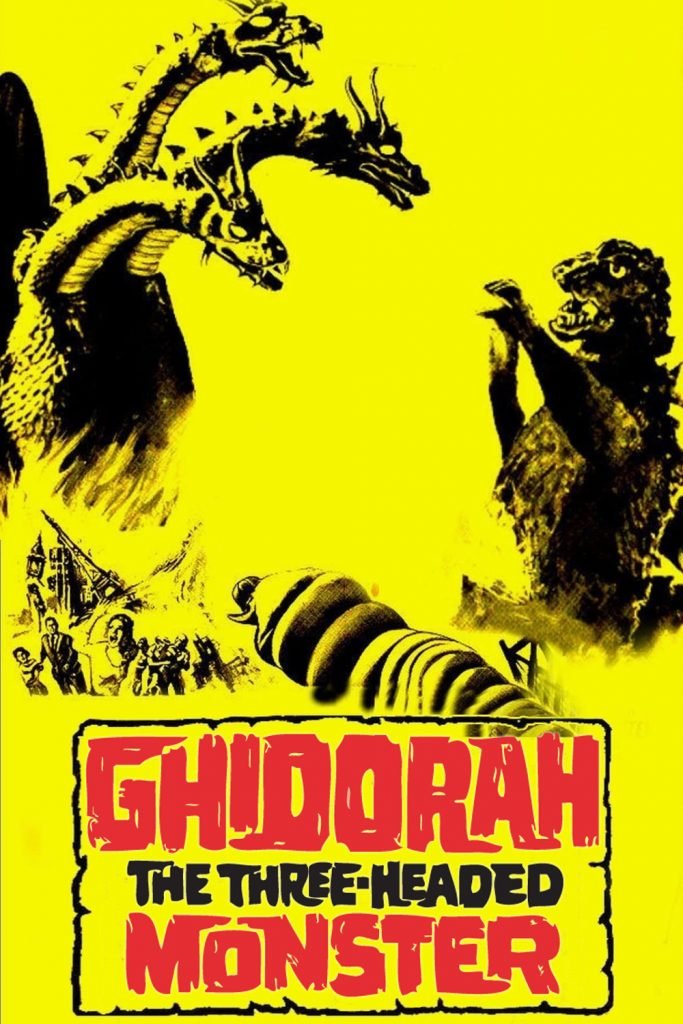
9. Ghidorah: The Three Headed Monster (1964)
The very first appearance of Godzilla’s greatest adversary comes in at number 9. Hailing all the way back from 1964, Ghidorah flew onto our screens in this classic. A lot of people will be much more familiar with 2019’s Godzilla: King of the Monsters which featured Rodan, Mothra and Ghidorah but this was the first time that all four monsters appeared on screen together. While I call this film a classic, the tale behind its development tends to cast some negativity on it. Ghidorah, the Three-Headed Monster was rushed into production due to Red Beard falling behind schedule and a replacement was needed for Toho’s New Year’s holiday slate. After the success of previous films where monsters were partnered up such as King Kong vs. Godzilla and Mothra vs. Godzilla, producer Tomoyuki Tanaka decided to develop a film that would feature Godzilla, Rodan and Mothra.
The film also includes a new monster, King Ghidorah. Ghidorah was designed as a homage to Yamata no Orochi. Yoshio Tsuchiya was originally attached to play Malmess but his commitments to Red Beard prevented him from participating. Honda felt “uncomfortable” with Toho and Eiji Tsuburaya’s decision to anthropomorphize the monsters, particularly the summit scene, stating, “I used the Peanuts as Mothra’s interpreters, but even that was something I had to force myself to do.” The film was shot in various locations, such as Mount Aso, Yokohama, Gotenba, and Ueno Park. Like most films in the series, this one got mixed reviews by critics with the English dub being trashed but the film is a lot of fun for those who enjoy classic movies.

8. Godzilla vs Hedorah (1971)
One of my personal favourites come in at number eight and it introduced us to Hedorah, the smog monster. The film was released theatrically in Japan on July 24, 1971. It received a theatrical release in the United States under the title Godzilla vs. the Smog Monster in July 1972 by American International Pictures. Director Banno initially conceived the idea for Godzilla vs. Hedorah after seeing cities like Yokkaichi covered in black smog and the ocean filled with foam from dumped detergent and formulated the story of an alien tadpole transforming into a monster as a result of the pollution. The film marked director Banno’s directorial debut; however, the budget for Godzilla vs. Hedorah was significantly lower than previous Godzilla films. Banno was only given 35 days to shoot the film and only had one team available to shoot both the drama and monster effects scenes.
Veteran Godzilla director Ishirō Honda was later tasked by producer Tomoyuki Tanaka to watch Banno’s rough cut and provide advice. Kenpachiro Satsuma, the actor who played Hedorah, was struck with appendicitis during the production. Doctors were forced to perform the appendectomy while he was still wearing the Hedorah suit, due to the length of time it took to take off. During the operation, Satsuma learned that painkillers had no effect on him. Director Yoshimitsu Banno was going to make a sequel to this film, but it was scrapped due to the fact that Tomoyuki Tanaka reportedly hated Godzilla vs. Hedorah, so he fired Yoshimitsu Banno. The next film was going to be called Godzilla vs. Redmoon, but this was scrapped and later became Daigoro vs. Goliath[citation needed], then they planned a new film called Godzilla vs. The Space Monsters: Earth Defensive Directive, but this was also scrapped and then became The Return of King Ghidorah, which was also scrapped, after which they ultimately made Godzilla vs. Gigan. The film also includes animated sequences, which were intended to convey the environmental message.

7. Godzilla vs Gigan (1972)
The direct sequel to Godzilla vs Hedorah comes up next and it introduced one of my favorite Godzilla villains ever in the titular Gigan. I have to clarify though, I am not giving this film the ranking that it got due to the absolutely nonsensical scene where Godzilla and Anguirus talk to each other. You read that right folks. In both versions of the film, those two monsters actually freaking talk to each other. Following the film’s release in Japan in March, 1972, Toho commissioned Hong Kong broadcaster and voice actor Ted Thomas to produce an English language dub. As was usual with Toho’s international export versions of its films, Godzilla vs. Gigan was left uncut, although the credits were changed to English.
One significant change was made for this international version. In the Japanese release, speech bubbles, as seen in comic books, are used to depict a conversation between Godzilla and Anguirus. The speech bubbles were removed in original prints of the English version and the conversation was dubbed into English with Thomas as the voice of Godzilla. I wish this scene wasn’t included but this was during a time when most Godzilla films were geared mostly for children. Outside of this, the film is pretty solid with a decent human plot and really good monster action.
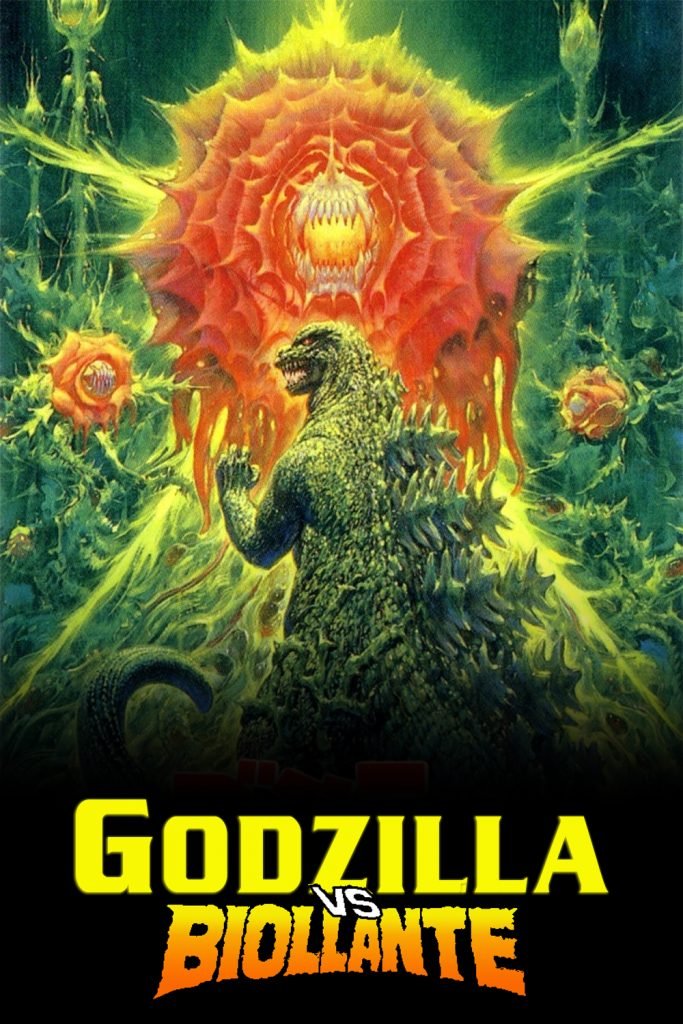
6. Godzilla vs. Biollante (1989)
Just missing out on the top 5 is Godzilla vs Biollante, a direct sequel to Godzilla Returns and one of the absolute best films in the series. In the film, Godzilla battles a monster born from the cells of a plant and a woman, as corporations struggle for control over Godzilla cells. The idea originated from a public story-writing contest, and set a trend common to all Heisei era movies, in which Godzilla faces off against opponents capable of metamorphosing into new, progressively more powerful forms. Godzilla vs. Biollante has received positive reviews, with praise for the story, music and visuals. Ed Godziszewski of Monster Zero said the film is “by no means a classic” but felt that “for the first time in well over 20 years, a [Godzilla] script is presented with some fresh, original ideas and themes.” Joseph Savitski of Beyond Hollywood said the film’s music is “a major detraction”, but added that it’s “not only one of the most imaginative films in the series but also the most enjoyable to watch.”
Japan Hero said, “This is definitely a Godzilla movie not to be missed.” In their scholarly book Japan’s Green Monsters on kaiju cinema, Rhoads and McCorkle offer an ecocritical assessment of Godzilla vs. Biollante. The scholars focus on the film’s critique of genetic engineering and biotechnology years before the subject appeared in more popular Hollywood blockbusters like Steven Spielberg’s 1993 blockbuster Jurassic Park. Rhoads and McCorkle counter prior reviews of the film and argue that Godzilla vs. Biollante possesses far deeper environmental messages than the obvious ones present on the film’s surface. In July 2014, in a poll reported by the Nihon Eiga Satellite Broadcasting Corporation, Godzilla vs. Biollante was selected as the best Godzilla film by a group of fans and judges. I don’t give this film a top 5 ranking mostly due to a kind of convoluted and weird human angle to the film, which I’ll just let you watch to see for yourself.

5. Godzilla vs Destroyah (1995)
In this film, Godzilla’s heart, which acts as a nuclear reactor, is nearing a nuclear meltdown that threatens the Earth. Meanwhile, a colony of mutated creatures known as Destoroyah emerge from the ocean, changing form and terrorizing Japan, forcing the Japanese Self-Defense Forces to devise a plan to eliminate both threats. Godzilla vs. Destoroyah received global publicity following an announcement by Toho that the film would feature the death of Godzilla. It was the final film to be scored by composer Akira Ifukube before his death in 2006, though his themes would continue to be used in subsequent films. This film is just barely beat out by one other from the Heisei era of films which I will discuss in the next entry. Destroyah is the one enemy who actually managed to kill Godzilla, that’s saying something.
The creature is created from the use of the Oxygen Destroyer, which was used to kill the original Godzilla in the very first film. Toho really went all out on this one and it shows just how good the production is. Critical and fan reaction to the film has been very positive. The Toho Kingdom said, “With an elegant style, a powerful plot, brilliant effects, and believable acting, this entry is definitely a notch above favourites from all three timelines, and its impact on the series is challenged by only a handful of competitors. Godzilla vs. Destoroyah is without a doubt a paradigm all its own.” Michael Hubert of Monster Zero praised the “spectacular monster battles,” calling Godzilla vs. Destoroyah “a great movie” and “one to add to your collection,” adding: “Even for non-Godzilla fans, this movie might help dispel some of the preconceptions you have about Godzilla’s ‘cheese factor’.
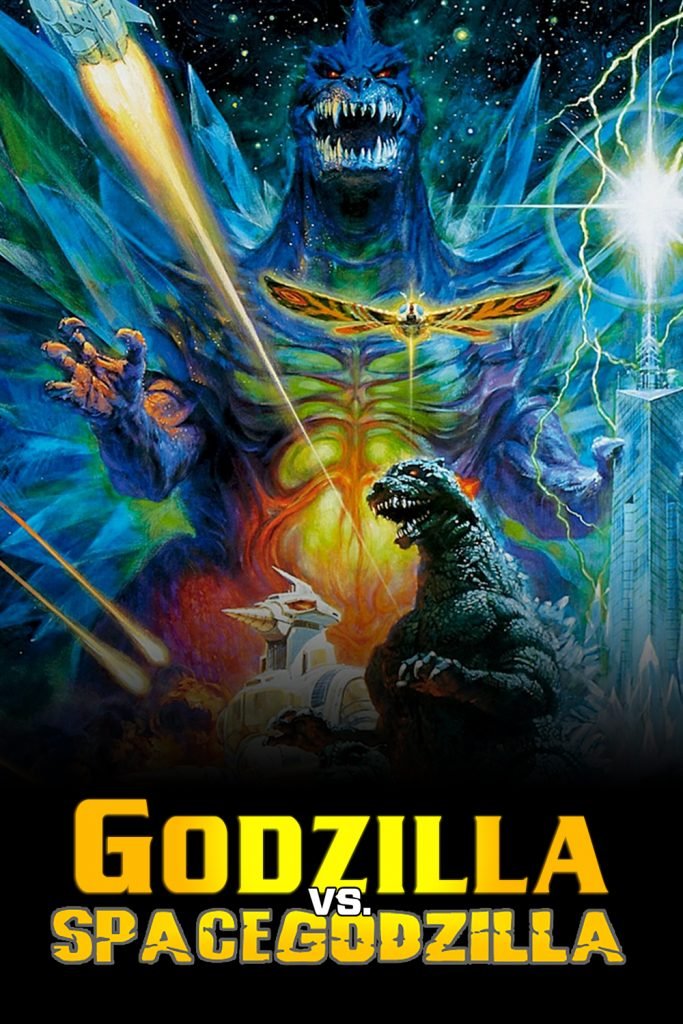
4. Godzilla vs Space Godzilla (1994)
This masterpiece is the 21st film in the Godzilla franchise, as well as the sixth film in the franchise’s Heisei series. The film is notable for the introduction of the monster SpaceGodzilla, as well as the re-introduction of the mecha character M.O.G.U.E.R.A.; its first appearance on-screen since the 1957 film The Mysterians. While the film received mainly mixed to negative reviews, I simply cannot agree with the critics on this one. Monster Zero called the film “a curiously uninvolving effort” that “disappoints in nearly all aspects of the production”. American Kaiju criticized the “wildly uneven pacing”, “uneven special effects”, and “exceedingly lumpy story”, but added that “most of the special effects are pretty fair” and “the monster battles are mostly fun.”
DVD Cult said, “It does have some great destruction scenes and monster battles; two things that make these films worthwhile to begin with. The monster SpaceGodzilla is excellently designed, and is certainly far more menacing than anything Dean Devlin and Roland Emmerich ever dreamed up.” Toho Kingdom said the film is “far from terrible” and “an underrated movie” but felt it suffered from an “overly complicated story”, “underdeveloped characters”, and “forgettable” music. For me, as I said above, I cannot agree with that assessment of the film. The villain monster is one of the coolest looking in the entire series of films and it really helped that it was basically Godzilla fighting himself. With just enough differences to make the villain monster different, Space Godzilla is one of few monsters who pushed Godzilla to the brink. The movie flows really well and it’s one of the better ones for story in my opinion. Give it a shot, don’t let the critic assessment deter you.

3. Godzilla vs Mecha-Godzilla (1973)
Number three of all time belongs to the 14th film of the Godzilla franchise, Godzilla vs Mecha Godzilla, and features the fictional monster characters Godzilla, Anguirus, and King Caesar, along with the mecha character Mechagodzilla. Godzilla vs. Mechagodzilla was released theatrically in Japan on March 21, 1974. The film received a limited release in the United States in 1977 by Cinema Shares, under the title Godzilla vs. the Bionic Monster. Like Godzilla 1985, this film holds a soft spot in my heart. It has one of the most memorable songs in the entire series, where Princess Nami has to awaken King Caesar. MechaG is one of the most bad ass villains in the entire Godzilla series and frankly, I loved how they introduced him to the world. Sure, the direct sequel of this film isn’t anywhere near as good as this one is, but you cannot decry this film for what the sequel did. Like a lot of the films in the Godzilla series, critics absolutely panned the film and criticized the hell out of it.
In a contemporary review in the Monthly Film Bulletin, Tony Rayns stated that at this point in the Godzilla series, there was no way the film “could have been anything other than formulary, but it could clearly have been much less shambling than it is.” Rayns noted that Shinichi Sekizawa’s story was “for once, quite ambitious” while noting that the film’s “‘mythic’ elements are never coherent or impressive enough to match the array of alien technology, and the script seems to forget all about fulfilling its own prophecies as it hurries towards the regulation free-style wrestling climax.” From retrospective reviews, Stuart Galbraith IV discussed the film in his book on Japanese genre films. Galbraith described the film as a “complete mess”, finding that the aliens in the film were a rip-off of Planet of the Apes and that the film had poor effects work and “equally poor direction of Jun Fukuda.” Galbraith opined that the film was “an improvement over Godzilla vs. Megalon, but that’s not saying much.” Among the positive attributes, Galbraith noted that Masaru Sato’s score was interesting and series veterans Akihiko Hirata, Hiroshi Koizumi and Kenji Sahara “make welcome appearances.” In Phil Hardy’s book Science Fiction (1984), a review stated that “the final fight is suitably impressive although the tongue-in-cheek reference to Leone slows the action down too much.” I’ve said it before and I’ll say it again. I cannot agree with critics 99 percent of the time and I definitely cannot with their assessment of this film. There are literally only two films in the entire series that are better than this one. That’s a life-long Godzilla fan telling you this. Check it out.

2. Mothra vs Godzilla (1964)
The second best film ever in the Godzilla franchise belongs to the 1964 film Mothra vs Godzilla. This is also the fourth film in the franchise, which should tell you about its staying power in my eyes. In the film, humans beseech the aide of the insect-god Mothra to stop Godzilla from destroying Japan.
Due to the success of King Kong vs. Godzilla (1962), Toho chose to pair Godzilla against Mothra for the following film, with Mothra chosen due to the success of Mothra (1961). Honda directly intended for the film to be meant for children in addition to adults, as a way to compete with television’s growing popularity in Japan. Notably, it is the final film in the franchise’s Shōwa period to depict Godzilla solely as an antagonist. Mothra vs. Godzilla was released theatrically in Japan on April 29, 1964. An edited version titled Godzilla vs. the Thing was released by American International Pictures in the United States on August 26, 1964.
Historian Steve Ryfle called the film’s themes as a “classic good-versus-evil stand-off”. He noted the film raises philosophical questions about unity and humanity’s will to put aside their differences for the greater good.
Ryfle refers to Godzilla as a “specter of nuclear annihilation”, metaphorically casting its shadow over Japan. Ryle also compares Godzilla as a “symbol of moral judgement” after indirectly killing the film’s villains. Actor Hiroshi Koizumi felt that Honda was able to emphasize his themes through Mothra better than Godzilla, stating, “Mothra’s role was a messenger of peace.” Kenji Sahara emphasized that his character “was a symbol of greed.” Honda purposely chose to portray the film’s version of Infant Island as a partial wasteland, stating, “I wanted to visualize the terror and the power of the atomic bomb.” Critical reception of this film was a bit more positive than usual and it gave us our first meeting between two of Toho’s most well known and most popular monsters. Mothra is one of the most popular monsters in cinema history and most Kaiju fans will have seen at least one of Mothra’s films outside of the Godzilla series. You’d do yourself a disservice if you don’t watch this masterpiece.
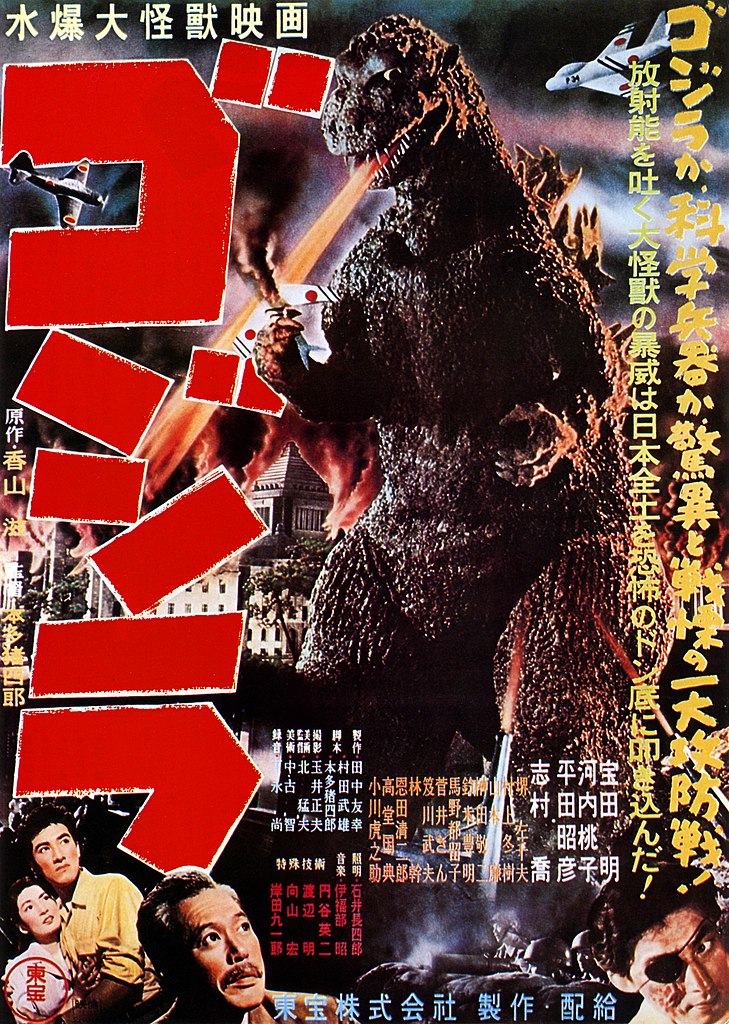
1. Godzilla (1954)
The #1 film of all time should have become clear to you all. The original Godzilla film from 1954 is by far the best film to ever be made. Of course, I absolutely love both the Japanese and American versions, despite the American version being quite heavily edited. The film spawned a multimedia franchise, being recognized by Guinness World Records as the longest-running film franchise in history. The character Godzilla has since become an international pop culture icon. The film and Tsuburaya have been largely credited for establishing the template for tokusatsu media. Since its release, the film has been regarded as a cinematic achievement and one of the best monster films ever made.
Godzilla ’54 is the one that started it all and I cannot emphasize just how much of a cinematic masterpiece this movie really is. While not my personal favourite film, I cannot take anything away from this absolutely phenomenal film. The American Version added the legendary Raymond Burr to the film and somehow, the American edit actually managed to not be entirely unwatchable. They managed to blend his scenes into the film in a way that mostly made sense as well as fit his character into the film. Sure, the Japanese version is still leaps and bounds better than the American, but you cannot take anything away from either film. Ask any true Godzilla fan about this film and they should say that it is one of, if not the, best film ever made for the franchise.
Thank you all for coming along on this extended series that looked at the King of the Monsters himself and all his movies. I’ll give you a final ranking below just in case you can’t quite remember. I’ll see you all again soon!
36. Godzilla – 1998
35. All Monsters Attack – 1969
34. Godzilla Raids Again – 1955
33. King Kong vs Godzilla – 1962
32. Son of Godzilla – 1967
31. Godzilla: Planet Eater – 2018
30. Godzilla: City on the Edge of Battle – 2018
29. Godzilla: Planet of the Monsters – 2017
28. Godzilla Final Wars – 2004
27. Godzilla vs the Sea Monster – 1966
26. Godzilla vs the Astro Monster – 1965
25. Godzilla vs Megaguirus – 2000
24. Godzilla vs Megalon – 1973
23. Godzilla 2000 – 1999
22. Godzilla vs Mothra – 1992
21. Terror of Mechagodzilla – 1975
20. Godzilla: King of the Monsters – 2019
19. Godzilla, Mothra and King Ghidorah: Giant Monsters All-Out Attack – 2001
18. Godzilla vs Mechagodzilla 2 – 1993
17. Shin Godzilla – 2016
16. Godzilla vs King Ghidorah – 1991
15. Godzilla – 2014
14. Godzilla vs Kong – 2021
13. Godzilla: Tokyo S.O.S. – 2003
12. Godzilla Against Mechagodzilla – 2002
11. Destroy All Monsters – 1968


